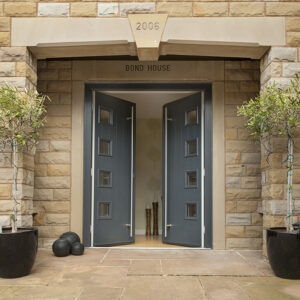Get A Quote
One of our team would be happy to have a chat with you about your requirements, answer any unanswered questions and measure up at a time that suits you to provide you a free, no obligation quote.
Following on from one of our latest blog on the anatomy of a casement window, for those of you thinking about improving your security this winter, we thought it would be helpful to list the whole anatomy of a composite door.
The term 'composite' means made up of several parts or elements.
Acrylonitrile Butadiene Styrene, also known as ABS, is a robust thermo-plastic skin used to reinforce timber core composite doors. Used to prevent fading, discolouring and scratches, to understand how tough it is, it is the same material used to make Lego.
Laminated veneer lumber, also known as LVL, offers an alternative to solid timber. Made by bonding multiple layers of veneer together, LVL engineered timber provides unmatched strength and dimensional stability.
Glass reinforced plastic, also known as GRP, is a high-impact resistant skin used to strengthen foam filled composite doors. Used to prevent fading, peeling, and warping, lightweight GRP is often used to protect and strengthen the hulls of boats. GRP can also be moulded to replicate authentic woodgrain finishes.
Accommodating a wide range of budgets, these composite door brands feature high density polyurethane foam cores protected by a durable GRP skin:

Composite doors with foam cores are made from high-density, CFC-free polyurethane foam. CFC-free means it doesn't contain chloroflurocarbons, which are harmful to the environment. Offering outstanding thermal performance, one drawback is that most foam filled composite doors can’t be fully recycled.
Timber core composite doors are thicker than other types of composite doors, making them one of the strongest and secure residential door replacement options available. Sourced from sustainable forests, timber core composites can be fully recycled at the end of their useful life.
A door rebate is the deep groove cut into the door frame that allows the slab to fit tightly against its frame. Single rebated composite doors have one groove and one weather seal.
Double rebated composite doors feature two grooves and two weather seals. Almost twice as thick as single rebate doors, double rebate composites offer extra insulation, security, and unique triple glazed options.
Glazed side panels are positioned on one side or both sides of the door.
A glazed panel positioned above the door.

The opening the door fits into.
A structural horizontal beam over the top of a door, generally used for load-bearing and decorative purposes. Typically found in homes built with brick or masonry blocks, lintels are usually made from concrete, timber, or steel.
The head, or head jamb, is the uppermost horizontal section of the door frame.
The vertical side sections of a door. The hinge side stile is the 'hinge stile' and the other side is known as the 'lock stile'.
A vertical beam that divides the frame and/or smaller glass units. Door mullions can also be used to separate two doors from each other.
The horizontal section that sits below the head jamb.
Also known as a cross rail, the freeze rail sits horizontally across the next divide down underneath the first panels on the door. (not all doors will have one)
The horizontal section that usually sits in line with the door handle.
The horizontal section that sits above the sill/cill.
Also known as the threshold, the sill/cill closes the gap between the bottom of the door and the floor.
Also known as a weatherboard, the weather bar is a sloping strip of timber, plastic or metal located at the bottom of an exterior door that ensures rainwater runs away from the panel and the bottom edge of the door.
The door frame is a collective term that covers the head jamb, the stiles, and the cill.
A metal plate that surrounds the keyhole for a sleek, decorative finish.
Interested in a new composite door or composite door repairs? Try our interactive Composite Door Builder, get a FREE quote, give us a call on 01932 344 415, or get in touch online to find out more.
Related reads:
Can composite doors reduce your energy bill?
What is the difference between composite and uPVC doors?
Our quick explanation for the different types of external doors
One of our team would be happy to have a chat with you about your requirements, answer any unanswered questions and measure up at a time that suits you to provide you a free, no obligation quote.
Sheerwater Glass provides window installation and repairs throughout Surrey and the surrounding areas of our Woking showroom. If you’re interested in our services, we encourage you to check if we serve customers in your area by simply typing in your postcode.
If you check and find that we don’t serve customers in your area, in some cases, we may be able to help. Please call us to find out more.